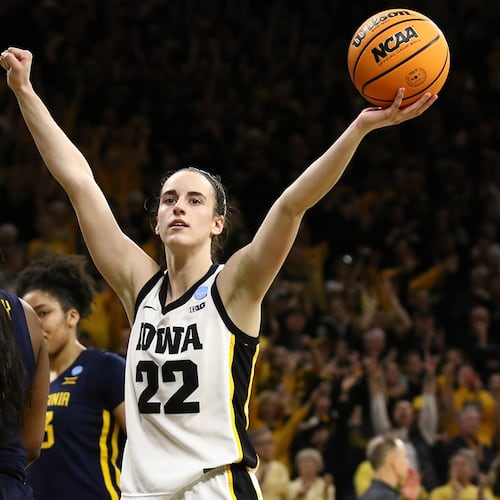It’s a lot of money for a pitcher who’ll turn 36 in December and whose last excellent season was in 2016. That said, it’s not my money. So hurrah for the Braves.
Cole Hamels once was among the best in the business. As a reward, he has made $19.5 million or more in every season since 2012. We recall him as part of those fabulous Philadelphia rotations – Roy Halladay, Cliff Lee and Roy Oswalt were other stalwarts – but he left the Phillies on July 31, 2015. He has gone from the Rangers to the Cubs, and now he’s coming here.
He’s coming here for one season at $18 million. The Braves just bought two-thirds of a season of Dallas Keuchel for $13 million, and Keuchel, at 31, was nearer his peak years than Hamels. But the Braves don’t want Hamels to start Game 1 of an October series for them, as Keuchel just did. (Not to great effect, we stipulate.) They want Hamels to solidify a rotation that wobbled last season.
He once was an ace. He hasn’t been for a while. For the Braves’ purposes, that’s OK. They’ve got Mike Soroka. They’ve got Max Fried. For better and for worse, they’ve got Mike Foltynewicz. Should those three work to their capabilities, Hamels will make a fine No. 4 starter. If not, he’d be a serviceable No. 3. He’s insurance rotation – expensive insurance, to be sure. Again, though, this is a one-year deal. They aren’t on the hook for anything beyond 2020.
We've mentioned this already, but here it is again: The Braves are absolutely in World Series mode. They've redone their bullpen, and not on the cheap. They've just grafted a quality left-hander onto a rotation that had the National League's seventh-best ERA last season, down from second-best in 2018. They hired Travis d'Arnaud to catch these guys. They are, as team exec Mike Plant said, going after it.
The Braves, it must be said, have Gone After It before, but lately not in such a sagacious way. Frank Wren had to rely on too many big-money-over-the-long-term free agents. (Think B.J. Upton and Derek Lowe.) The post-Wren rebuild left the organization with a top-shelf farm system, which means Alex Anthopoulos, who inherited that bounty from John Coppolella, doesn’t have to buy everything at market price. He has home-cultivated if not homegrown assets: Soroka, Fried, Foltynewicz, Sean Newcomb, Ronald Acuna, Ozzie Albies, Dansby Swanson, Austin Riley.
The trick is in balancing in-house development with outside purchases. Two years on the job, Anthopoulos has been an ace at that. Over the past 13 months, he has spent $54 million for Josh Donaldson, Keuchel and now Hamels, but they were/are one-year deals. The Braves are using free agency in a different way than Wren, who paid $75.25 million over five seasons for the raging-dud Upton and $60 mil over four for Lowe, who wasn’t terrible – he helped get the Braves to the 2010 playoffs – but wasn’t great.
Meanwhile, the farm system has remained mostly untouched. Kolby Allard, the Braves’ No. 1 pick in 2015, was shipped to Texas in the Chris Martin deal, and Joey Wentz, the Braves’ second pick in 2016, went to Detroit for Shane Greene. Neither, however, was the best Braves pitcher of his draft class: Soroka had blown past Allard; Ian Anderson remains more highly regarded than Wentz. There hasn’t been a raze-the-chain trade under this general manager. (Braves-watchers refer to that as a “Mark Teixeira.”)
For half a year, Braves fans have wondered when their team would move for Madison Bumgarner, postseason demon. The trade deadline passed with MadBum still a Giant. He became a free agent in November, and this seemed as logical a landing spot as any. But Bumgarner, who’s 30, isn’t at the spot in his career to take a one-year deal. Even if he’s no longer at his peak, he’s looking for long-term security. MLB Trade Rumors predicted he’ll get $72 million over four years. He won’t get it here, though.
Yes, $72 million divided by four is $18 million, which is what the Braves are paying Hamels, who’s 5-1/2 years older. But the Braves have determined – they aren’t alone in this – that one-year outlays will never compromise a team’s future in the way four- and five-year deals can and do. The catch is that you’re keep buying year-to-year, but how much of a downside is that? Keuchel comes off the books; you replace him with Hamels.
Short of re-upping Donaldson, the Braves have done as much as they can do – and they’ve done before baseball convenes for its winter meetings – to better their team for next year. Seeing Donaldson sign elsewhere would, alas, be a blow. (And Mike Moustakas, the third-base fallback for failed suitors of Donaldson and Anthony Rendon, just alit with the Reds.) But the Braves will head to San Diego for the long weekend with a compelling case to make to any prospective signee.
They’ve won the National League East two years running. They’ve found a catcher, redone their bullpen and signed a starter who’s a former World Series MVP. “Sign with us,” they can say, “and you could have a ring this time next year.”
And they wouldn’t be kidding. This team is taking dead aim at greatness.
About the Author
The Latest
Featured


